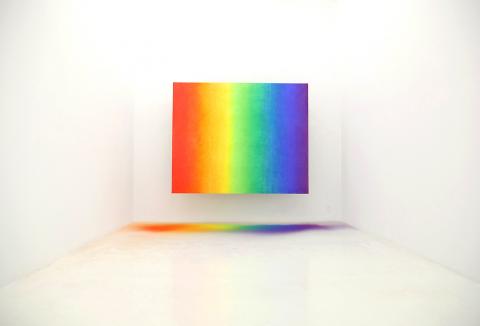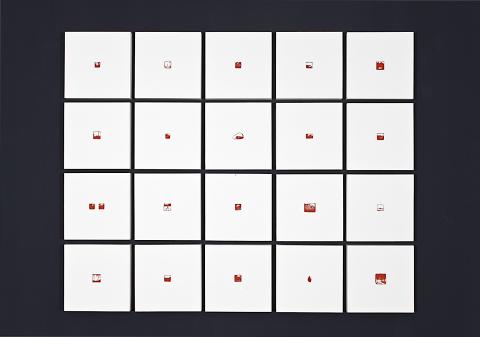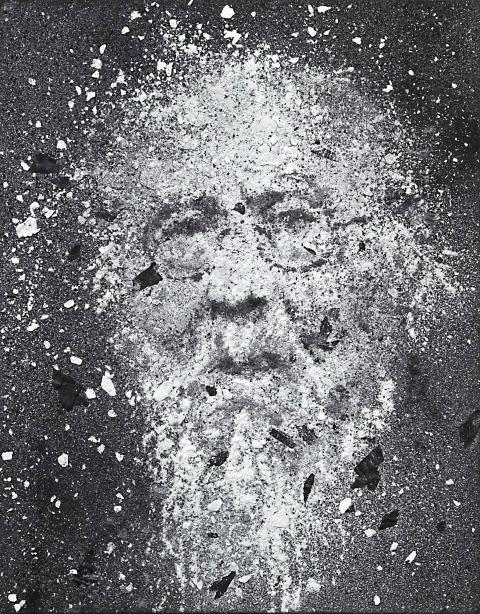Influenced by Italo Calvino’s 1972 novel Invisible Cities, Ibid (如前所述) is a solo exhibition by UK artist Alec Shepley at the Kuandu Museum of Fine Arts which tackles the question of what to do with our worldly possessions once there is no longer a use for them. In order to create this hypothetical world, Shepley uses mixed media such as found and made objects, photographs and sound. Calvino’s book introduces the idea that the human imagination is not limited by the laws of physics. When converted to art, the results are gravity-defying — for instance, abandoned houses on avatar-like pods. Ibid is a literary citation used in footnotes to indicate that the same book is being cited again. Although the shoddiness of Shepley’s artwork may not appear methodological, the exhibition title nevertheless alludes to the process of renewal or redefinition.
■ Kuandu Museum of Fine Arts (關渡美術館), 1 Xueyuan Rd, Taipei City (台北市學園路1號), tel: (02) 2896-1000 ext 2432. Open Tuesdays to Sundays from 10am to 5pm
■ Until Feb. 15

Photo courtesy of Asia Art Center II
Absolute Art Space in Greater Tainan frequently showcases quirky and creative contemporary art by up-and-coming artists. Currently on display is The Great Scenery (大景), a joint exhibition by 82 artists from around Taiwan which highlights the depth and diversity of what we call “contemporary” art. Tainan native Wu Chuan-lun (吳權倫), who uses mixed media such as computer generated images, carvings and paintings to create three-dimensional-like rainbow shapes, is one of the artists being exhibited. Chi New-york (紀紐約) who, despite his New York-sounding name, hails from Greater Kaohsiung, is another mixed-media artist represented at the show, although his photography of somber-looking women playing sports is more pensive than active. The Great Scenery covers a wide range, from the chaotic to the subdued, but tying it all together is a unifying sense of freedom and plurality.
■ Absolute Art Space (絕對空間), 11, Lane 205, Minsheng Rd Sec 1, Greater Tainan (台南市民生路一段205巷11號), tel: (06) 223-3508, open from Tuesdays to Fridays 12pm to 8pm and Saturdays and Sundays from 2pm to 8pm
■ Until Feb. 23

Photo courtesy of Asia Art Center II
2014 IT PARK Limited Editions (2014 伊通公園限量版) is a collection of the works of 15 artists who were influential in jettisoning the new style of abstract and modern Taiwanese art. The lineup includes Paul Chiang (江賢二) who is most famous for his paintings of colorful overlapping hibiscuses created by splashes of brush strokes on canvases large enough to fill up entire rooms. Also included is Jason Chi (紀嘉華) who’s teal-and-yellow linear paintings created by mixing scraping techniques and brush strokes encapsulate the meticulous simplicity of abstract art.
■ IT Park Gallery (伊通公園), 2F-3F, 41 Yitong St, Taipei City (台北市伊通街41號2-3樓). Open Tuesdays to Saturdays from 1pm to 10pm. Tel: (02) 2507-7243
■ Until Feb. 28

Photo courtesy of Taipei Fine Arts Museum
When Chinese artist Zhang Hongtu (張宏圖) was eating oatmeal for breakfast in his New York apartment one day in the late 80s, he noticed an uncanny resemblance between the Quaker Oats man and Mao Zedong (毛澤東). And so began Zhang’s series of “political pop” in which he superimposes the former chairman’s face onto iconic backdrops from pop culture. The effect is simultaneously comical and critical and gives a poignant insight into the excess-filled lives that the Communist Party elite lived. His artwork can be viewed at Tina Keng Gallery in a solo exhibition entitled The Journey Begins: Zhang Hongtu 1985-2004 (啟程:張宏圖--作品選 ).
■ Tina Keng Gallery (耿畫廊), 15, Ln 548, Ruiguang Rd, Taipei City (台北市瑞光路548巷15號), tel: (02) 2659-0798. Open Tuesdays to Sundays from 10am to 7pm
■ Until Mar. 1

Photo courtesy of Taipei Fine Arts Museum
The poems, paintings and art installations created by some very talented eighth grade students from Jian Cheng Junior High School (建成國民中學) are currently on display at the Museum of Contemporary Art in Taipei in an exhibition with the lyrical-sounding name of A Beautiful Aurora Art and Poetry Project (一道美麗的極光-藝術詩文計畫). As part of the Artist in School Residence Program, the students were trained by poet-playwright Hung Hung (鴻鴻, Yen Hung-ya 閻鴻亞) as well as visual artist Lin Chun-ju (林純如). The result is a contemplative exhibition in which the students’ innermost thoughts are fleshed out in semblances of objects and scenes from their everyday life.
■ Museum of Contemporary Art, Taipei (台北當代藝術館, MOCA), 39 Chang-an W Rd, Taipei City (台北市長安西路39號), tel: (02) 2552-3720. Open Tuesdays to Sundays from 10am to 6pm
■ Until March 8
In a changing art world where lines between different media are increasingly blurred and 2D can easily morph into 3D, Asia Art Center II presents an exhibition that questions our perception of painting. This is Not Painting: Exploring the Boundary of Painting (不是繪畫-關於繪畫邊界的探索) is a joint exhibition by five young Chinese artists whose works “breach two-dimensionality, or…transforms the nature of methodology,” according to the gallery notes. Today is the last day that Dong Dawei (董大為) will be creating artwork on-site at the gallery. He lets the chalk residue from his colorful pastel paintings fall to the ground. The traces themselves become part of the artwork, demonstrating both fleeting and everlasting qualities of painting. Also on display are Li Yiwen’s (李易紋) “seal engravings” which he creates with a knife rather than a paintbrush.
■ Asia Art Center II (亞洲藝術中心二館), 93, Lequn 2nd Road, Taipei City (台北市樂群二路93號), tel: (02) 8502-7939. Open Tuesdays to Sundays from 10am to 6:30pm
■ Opens tomorrow. Until March 29
The Wondrous All: Leading Edge: Leading Edge of Eastern Thought (眾妙生鋒:東方思維之情愫) is a joint exhibition of Taiwanese and Chinese artists which “probe the eastern roots of national culture from the perspective of ideology, philosophy, literature, psychology and sociology,” according to the gallery notes. On display are Chinese artist Cai Zhisong’s (蔡志松) fiber-glass and metal sculptures of Qin Dynasty warriors and servants converted into modern-day men striking comical or suggestive poses. Also on the lineup is Chinese artist Zhang Huan (張洹) who is known for Family Tree — an installation in which calligraphers write characters on his face until words and face were completely obliterated. From Taiwan, there i (李義弘), who does tantalizing ink portraits of nude women.
■ Taipei Fine Arts Museum (台北市立美術館 TFAM), 181, Zhongshan N Rd Sec 3, Taipei (台北市中山北路三段181號), tel: (02) 2595-7656. Open Tuesdays to Sundays from 9:30am to 5:30pm and until 8:30pm on Saturdays
■ Opens tomorrow. Until May 3

In the March 9 edition of the Taipei Times a piece by Ninon Godefroy ran with the headine “The quiet, gentle rhythm of Taiwan.” It started with the line “Taiwan is a small, humble place. There is no Eiffel Tower, no pyramids — no singular attraction that draws the world’s attention.” I laughed out loud at that. This was out of no disrespect for the author or the piece, which made some interesting analogies and good points about how both Din Tai Fung’s and Taiwan Semiconductor Manufacturing Co’s (TSMC, 台積電) meticulous attention to detail and quality are not quite up to

April 21 to April 27 Hsieh Er’s (謝娥) political fortunes were rising fast after she got out of jail and joined the Chinese Nationalist Party (KMT) in December 1945. Not only did she hold key positions in various committees, she was elected the only woman on the Taipei City Council and headed to Nanjing in 1946 as the sole Taiwanese female representative to the National Constituent Assembly. With the support of first lady Soong May-ling (宋美齡), she started the Taipei Women’s Association and Taiwan Provincial Women’s Association, where she

Chinese Nationalist Party (KMT) Chairman Eric Chu (朱立倫) hatched a bold plan to charge forward and seize the initiative when he held a protest in front of the Taipei City Prosecutors’ Office. Though risky, because illegal, its success would help tackle at least six problems facing both himself and the KMT. What he did not see coming was Taipei Mayor Chiang Wan-an (將萬安) tripping him up out of the gate. In spite of Chu being the most consequential and successful KMT chairman since the early 2010s — arguably saving the party from financial ruin and restoring its electoral viability —

It is one of the more remarkable facts of Taiwan history that it was never occupied or claimed by any of the numerous kingdoms of southern China — Han or otherwise — that lay just across the water from it. None of their brilliant ministers ever discovered that Taiwan was a “core interest” of the state whose annexation was “inevitable.” As Paul Kua notes in an excellent monograph laying out how the Portuguese gave Taiwan the name “Formosa,” the first Europeans to express an interest in occupying Taiwan were the Spanish. Tonio Andrade in his seminal work, How Taiwan Became Chinese,